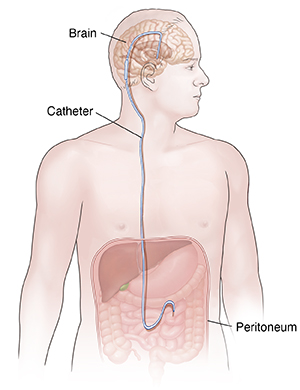Having a Ventriculoperitoneal Shunt
Ventriculoperitoneal (VP) shunting is a type of brain surgery. It’s done to drain extra cerebrospinal fluid (CSF) from the brain. A tube (catheter) is put in the brain. This tube runs under the skin to the lining of the abdomen (peritoneum). It carries CSF there to be safely absorbed by the body.

How to say it
vehn-TRIHK-yuh-loh-pehr-eh-tuh-NEEL
Why is VP shunting done?
VP shunting is done to treat hydrocephalus. This condition is sometimes called “water on the brain.” It’s when too much CSF builds up in the brain. Too much of this fluid can cause too much pressure on the brain, leading to brain damage. VP shunting may also be done to ease increased pressure if you have idiopathic intracranial hypertension (IIH).
CSF surrounds your brain and spinal cord and acts as a cushion. Your brain normally has a certain level of CSF in it. But CSF can build up if your brain is injured. This might be from a stroke, a tumor, or blow to the head. Hydrocephalus may also occur for no known reason in older adults. In IIH, CSF pressure builds up for an unknown reason. It causes headache and loss of sight.
How is VP shunting done?
VP shunting is done in a hospital. It uses a catheter to carry CSF out of the brain to the lining of the abdomen. This tube runs just under the skin. A small valve connected to the tube helps control the flow of CSF from the brain.
-
You lie face up on the operating table. A healthcare provider may place a headrest underneath you to better align your body and head for the surgery.
-
You are given medicine to make you fall asleep. You won’t feel any pain. You may also be given antibiotics to prevent an infection.
-
A small area of hair on your head may be trimmed. This is where the surgeon will make a cut to reach your brain.
-
The surgeon makes a cut in your belly (abdomen) to reach the lining of the abdomen (peritoneum).
-
The surgeon then makes a cut on your scalp. It may be on the back of your head or behind the ear. The surgeon then drills a small hole into your brain. This hole will hold the valve for the tube.
-
A tube will be tunneled under your skin from the small hole in your scalp to the cut in your abdomen.
-
The end of the tube will be carefully placed into the peritoneum.
-
The surgeon puts the other end of the tube into your brain. A valve is attached to this tube. It allows CSF to flow out when it builds up in the brain.
-
The surgeon tests the tube and the valve to make sure it's working right.
-
The surgeon closes up the cut in your belly and scalp with sutures.
Risks of VP shunting
VP shunting is a very safe procedure. However, complications can occur such as:
When to call your healthcare provider
Call your healthcare provider right away if you have any of the following:
-
An unexplained fever, especially if linked to a stiff neck or confusion
-
New seizures or change in seizure pattern
-
Unusual headache
-
Sluggishness (lethargy)
-
Visual changes
-
Redness, swelling, bleeding, or discharge from the area where the shunt valve was placed
Online Medical Reviewer:
Anne Fetterman RN BSN
Online Medical Reviewer:
Joseph Campellone MD
Online Medical Reviewer:
Raymond Kent Turley BSN MSN RN
Date Last Reviewed:
4/1/2022
© 2000-2024 The StayWell Company, LLC. All rights reserved. This information is not intended as a substitute for professional medical care. Always follow your healthcare professional's instructions.